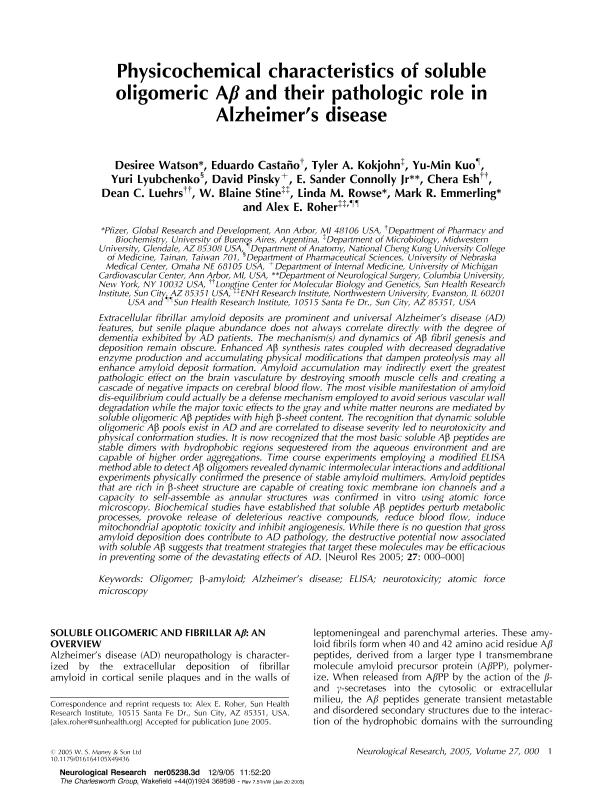Mostrar el registro sencillo del ítem
dc.contributor.author
Watson, Desiree
dc.contributor.author
Castaño, Eduardo Miguel

dc.contributor.author
Kokjohn, Tyler A.
dc.contributor.author
Kuo, Yu Min
dc.contributor.author
Lyubchenko, Yuri
dc.contributor.author
Pinsky, David
dc.contributor.author
Connolly, E. Sander
dc.contributor.author
Esh, Chera
dc.contributor.author
Luehrs, Dean C.
dc.contributor.author
Stine, W. Blaine
dc.contributor.author
Rowse, Linda M.
dc.contributor.author
Emmerling, Mark R.
dc.contributor.author
Roher, Alex E.
dc.date.available
2018-04-27T17:43:47Z
dc.date.issued
2013-12
dc.identifier.citation
Watson, Desiree; Castaño, Eduardo Miguel; Kokjohn, Tyler A.; Kuo, Yu Min; Lyubchenko, Yuri; et al.; Physicochemical characteristics of soluble oligomeric A β and their pathologic role in Alzheimer's disease; Maney Publishing; Neurological Research; 27; 8; 12-2013; 869-881
dc.identifier.issn
0161-6412
dc.identifier.uri
http://hdl.handle.net/11336/43663
dc.description.abstract
Extracellular fibrillar amyloid deposits are prominent and universal Alzheimer's disease (AD) features, but senile plaque abundance does not always correlate directly with the degree of dementia exhibited by AD patients. The mechanism(s) and dynamics of Abeta fibril genesis and deposition remain obscure. Enhanced Abeta synthesis rates coupled with decreased degradative enzyme production and accumulating physical modifications that dampen proteolysis may all enhance amyloid deposit formation. Amyloid accumulation may indirectly exert the greatest pathologic effect on the brain vasculature by destroying smooth muscle cells and creating a cascade of negative impacts on cerebral blood flow. The most visible manifestation of amyloid dis-equilibrium could actually be a defense mechanism employed to avoid serious vascular wall degradation while the major toxic effects to the gray and white matter neurons are mediated by soluble oligomeric Abeta peptides with high beta-sheet content. The recognition that dynamic soluble oligomeric Abeta pools exist in AD and are correlated to disease severity led to neurotoxicity and physical conformation studies. It is now recognized that the most basic soluble Abeta peptides are stable dimers with hydrophobic regions sequestered from the aqueous environment and are capable of higher order aggregations. Time course experiments employing a modified ELISA method able to detect Abeta oligomers revealed dynamic intermolecular interactions and additional experiments physically confirmed the presence of stable amyloid multimers. Amyloid peptides that are rich in beta-sheet structure are capable of creating toxic membrane ion channels and a capacity to self-assemble as annular structures was confirmed in vitro using atomic force microscopy. Biochemical studies have established that soluble Abeta peptides perturb metabolic processes, provoke release of deleterious reactive compounds, reduce blood flow, induce mitochondrial apoptotic toxicity and inhibit angiogenesis. While there is no question that gross amyloid deposition does contribute to AD pathology, the destructive potential now associated with soluble Abeta suggests that treatment strategies that target these molecules may be efficacious in preventing some of the devastating effects of AD.
dc.format
application/pdf
dc.language.iso
eng
dc.publisher
Maney Publishing

dc.rights
info:eu-repo/semantics/openAccess
dc.rights.uri
https://creativecommons.org/licenses/by-nc-sa/2.5/ar/
dc.subject
Amyloid Beta
dc.subject
Oligomers
dc.subject
Alzheimer'S Disease
dc.subject.classification
Otras Ciencias Biológicas

dc.subject.classification
Ciencias Biológicas

dc.subject.classification
CIENCIAS NATURALES Y EXACTAS

dc.title
Physicochemical characteristics of soluble oligomeric A β and their pathologic role in Alzheimer's disease
dc.type
info:eu-repo/semantics/article
dc.type
info:ar-repo/semantics/artículo
dc.type
info:eu-repo/semantics/publishedVersion
dc.date.updated
2018-04-05T19:22:46Z
dc.identifier.eissn
1743-1328
dc.journal.volume
27
dc.journal.number
8
dc.journal.pagination
869-881
dc.journal.pais
Reino Unido

dc.journal.ciudad
London
dc.description.fil
Fil: Watson, Desiree. Pfizer Global Research and Development; Estados Unidos
dc.description.fil
Fil: Castaño, Eduardo Miguel. Consejo Nacional de Investigaciones Científicas y Técnicas. Oficina de Coordinación Administrativa Parque Centenario. Instituto de Investigaciones Bioquímicas de Buenos Aires. Fundación Instituto Leloir. Instituto de Investigaciones Bioquímicas de Buenos Aires; Argentina
dc.description.fil
Fil: Kokjohn, Tyler A.. Midwestern University; Estados Unidos
dc.description.fil
Fil: Kuo, Yu Min. National Cheng Kung University; República de China
dc.description.fil
Fil: Lyubchenko, Yuri. University of Nebrasca; Estados Unidos
dc.description.fil
Fil: Pinsky, David. University of Michigan; Estados Unidos
dc.description.fil
Fil: Connolly, E. Sander. Columbia University; Estados Unidos
dc.description.fil
Fil: Esh, Chera. Sun Health Research Institute; Estados Unidos
dc.description.fil
Fil: Luehrs, Dean C.. Sun Health Research Institute; Estados Unidos
dc.description.fil
Fil: Stine, W. Blaine. Midwestern University; Estados Unidos
dc.description.fil
Fil: Rowse, Linda M.. Midwestern University; Estados Unidos
dc.description.fil
Fil: Emmerling, Mark R.. Midwestern University; Estados Unidos
dc.description.fil
Fil: Roher, Alex E.. Sun Health Research Institute; Estados Unidos
dc.journal.title
Neurological Research

dc.relation.alternativeid
info:eu-repo/semantics/altIdentifier/url/https://www.tandfonline.com/doi/abs/10.1179/016164105X49436
dc.relation.alternativeid
info:eu-repo/semantics/altIdentifier/doi/https://doi.org/10.1179/016164105X49436
Archivos asociados
